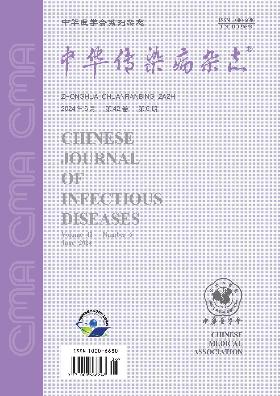严重发热伴血小板减少综合征患者与恙虫病患者临床表现及器官损害的差异
引用次数: 0
摘要
目的分析严重发热伴血小板减少综合征(SFTS)患者与恙虫病患者的临床表现和器官损伤的差异,探讨SFTS的预后因素。方法对2014年10月至2017年6月在安徽医科大学附属第一医院就诊的49例SFTS患者和16例恙虫病患者进行研究。评估患者的一般信息,包括地区、年龄、性别和临床表现。在病程中持续监测血常规、肝肾功能、心肌酶水平、脂肪酶、淀粉酶、电解质、C反应蛋白、降钙素原、凝血酶原时间(PT)和活化部分凝血活酶时间(APTT)。正态分布的连续变量采用T检验,非正态分布变量采用非参数检验。分类变量采用卡方检验。结果SFTS患者平均年龄为62.1±15.5(17~87岁),恙虫病患者平均年龄56.1±9.2(47~73岁)。两组间无显著性差异(t=1.47,P=0.147)。SFTS患者中有25名男性(51%),恙虫病患者中有8名男性(50%)。头痛、呕吐、浅表淋巴结肿大、意识障碍、蛋白尿、血尿、肺部感染、,SFTS患者的多器官功能障碍和急性胰腺炎均显著高于恙虫病患者(χ2=8.82、4.38、8.71、11.17、7.88、5.56、4.35、9.43和8.13,P<0.05或0.01),SFTS患者血清天冬氨酸转氨酶(Z=2.94)、乳酸脱氢酶(Z=3.42)、肌酸激酶(CK)(Z=2.88)、淀粉酶(Z=2.77)、脂肪酶(Z=2.22)、,致死性SFTS患者血清肌酐(Z=2.07)和尿素氮(Z=2.50)均显著高于恙虫病患者(P<0.05或0.01),49例SFTS患者中死亡16例,最终康复33例。两个亚组的年龄(t=3.33)、血小板计数(Z=2.55)、丙氨酸氨基转移酶(ALT)(Z=2.10)、天冬氨酸氨基转移酶,而恙虫病的预后较好。早期鉴别诊断和早期合理治疗对于降低SFTS患者的死亡率非常重要。关键词:恙虫病;严重发热伴血小板减少综合征;新布尼亚病毒;器官损伤本文章由计算机程序翻译,如有差异,请以英文原文为准。
Differences of clinical manifestations and organ damage between patients with severe fever with thrombocytopenia syndrome and patients with tsutsugamushi disease
Objective
To analyze the differences of clinical manifestations and organ damage between patients with severe fever with thrombocytopenia syndrome(SFTS) and patients with tsutsugamushi disease, and to investigate the prognostic factors of SFTS.
Methods
The research was performed on 49 patients with SFTS and 16 patients with tsutsugamushi disease who visited the First Affiliated Hospital of Anhui Medical University from October 2014 to June 2017. The general information of patients including region, age, gender and clinical manifestations were evaluated. Blood routine, liver and kidney function, myocardial enzyme levels, lipase, amylase, electrolytes, C-reactive protein, procalcitonin, prothrombin time(PT) and activated partial thromboplastin time(APTT) were continuously monitored during the course of disease. T test was used for continuous variables of normal distribution, and non-parametric test was used for variables of non-normal distribution. Chi-square test was used for categorical variables.
Results
The mean age of SFTS patients was 62.1±15.5(ranging from 17 to 87 years) and the mean age of tsutsugamushi patients was 56.1±9.2 (ranging from 47 to 73 years). There was no significant difference between the two groups (t=1.47, P=0.147). There were 25 males(51%) in SFTS patients and 8 males (50%) in tsutsugamushi disease patients. There was no significant difference between the two groups (χ2=0.005, P=0.943). The incidences of headache, vomiting, superficial lymphadenectasis, disturbance of consciousness, proteinuria, hematuria, pulmonary infection, multiple organ dysfunction and acute pancreatitis in SFTS patients were all significantly higher than those in tsutsugamushi disease patients (χ2=8.82, 4.38, 8.71, 11.17, 7.88, 5.56, 4.35, 9.43, and 8.13, respectively, P<0.05 or 0.01). The counts of leukocytes (Z=2.73), neutrophils (Z=2.46), lymphocytes (Z=3.15), platelets (Z=4.25), albumin (Z=2.65) and sodium ion (t=2.10) in SFTS patients were all significantly lower than those in patients with tsutsugamushi disease (P<0.05 or 0.01). The levels of aspartate aminotransferase (Z=2.94), lactate dehydrogenase (Z=3.42), creatine kinase(CK)(Z=2.88), amylase (Z=2.77), lipase (Z=2.82), creatinine (Z=2.07) and urea nitrogen (Z=2.50) in fatal SFTS patients were all significantly higher than those in patients with tsutsugamushi disease (P<0.05 or 0.01). Among 49 SFTS patients, 16 patients died and 33 patients recovered finally. The age(t=3.33), platelet count (Z=2.55), alanine aminotransferase (ALT)(Z=2.10), aspartate aminotransferase (AST)(Z=2.22), lactate dehydrogenase (Z=2.26), CK(Z=3.50), CK-MB (Z=3.10), creatinine (Z=2.17), urea nitrogen (Z=2.36), and sodium (t=2.65) between the two subgroups had significant differences (P<0.05 or 0.01).
Conclusions
SFTS is more severe and has high mortality, while tsutsugamushi disease has a better prognosis. Early differential diagnosis and early rational treatment are important to reduce the mortality of patients with SFTS.
Key words:
Scrub typhus; Severe fever with thrombocytopenia syndrome; New bunyavirus; Organ damage
求助全文
通过发布文献求助,成功后即可免费获取论文全文。
去求助
来源期刊
自引率
0.00%
发文量
5280
期刊介绍:
The Chinese Journal of Infectious Diseases was founded in February 1983. It is an academic journal on infectious diseases supervised by the China Association for Science and Technology, sponsored by the Chinese Medical Association, and hosted by the Shanghai Medical Association. The journal targets infectious disease physicians as its main readers, taking into account physicians of other interdisciplinary disciplines, and timely reports on leading scientific research results and clinical diagnosis and treatment experience in the field of infectious diseases, as well as basic theoretical research that has a guiding role in the clinical practice of infectious diseases and is closely integrated with the actual clinical practice of infectious diseases. Columns include reviews (including editor-in-chief reviews), expert lectures, consensus and guidelines (including interpretations), monographs, short monographs, academic debates, epidemic news, international dynamics, case reports, reviews, lectures, meeting minutes, etc.

 求助内容:
求助内容: 应助结果提醒方式:
应助结果提醒方式:


